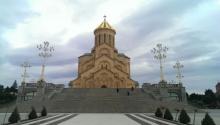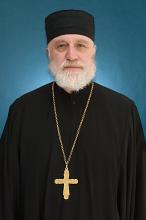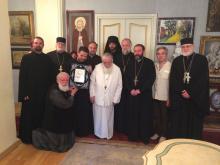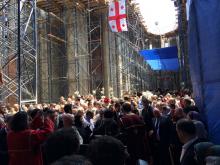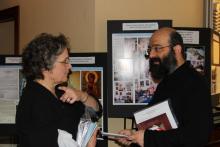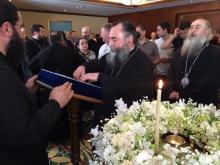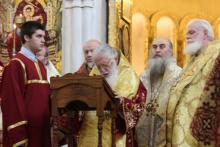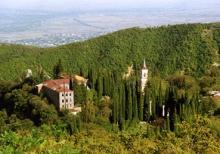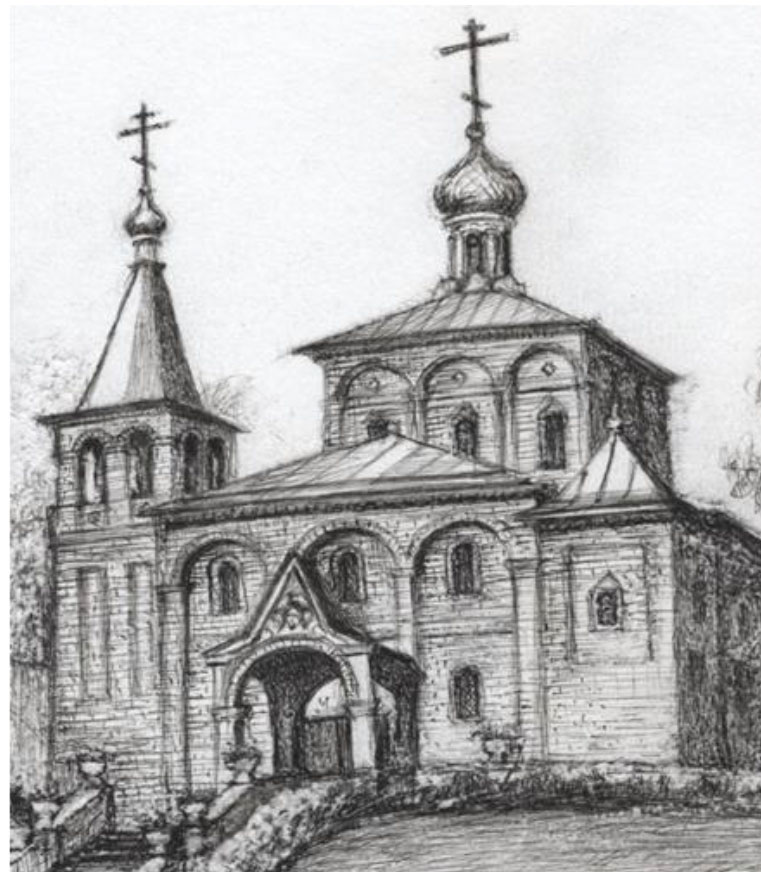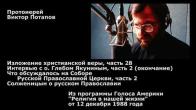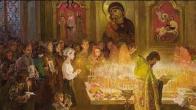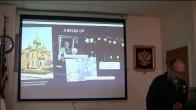You are here
2014.08.12. "The First Earthly Appanage of the Most Holy Theotokos:" Pilgrim’s Notes by Archpriest Victor Potapov
An appanage (or lot) of the Theotokos is holy land under particular protection and patronage of the Mother of God. There are four such holy sites on earth: Iberia (Georgia), the Holy Mountain (Mt. Athos, Greece), the Kiev Caves Lavra (Ukraine), and St. Seraphim-Diveevo Monastery (Russia). This article will deal with the first earthly appanage of the Most Holy Theotokos – Georgia.
Church Tradition tells us that, after the Ascension of our Lord Jesus Christ, the Apostles gathered in the Upper Room and cast lots to see who among them would travel to which country to preach the Gospel. The Mother of God said that she, too, wished to cast lots alongside the Apostles and receive a land, appointed to her by the Lord. Her lot fell on Iberia. The Theotokos joyfully accepted her lot, and immediately after the Descent of the Holy Spirit on the Apostles, desired to travel to the Iberian land and preach the word of God there. But an angel of the Lord appeared to her and bade her stay in Jerusalem, vowing that her lot would be accomplished in due time. Then the Mother of God, calling the Apostles Andrew and Simon, entrusted them with an image of herself not made by hands, with which to bless Georgia. The Most Holy Virgin never did come to Iberia in the flesh, but the mercy of the Heavenly Queen nevertheless abides in Georgia.
The Holy Apostles Andrew, Matthias, Bartholomew, and Simon the Canaanite (the Zealot) all preached in Georgia, blessing that land with their presence. Their labors represent the early dawn of Georgian Orthodoxy.
The Christianization of Georgia in the 4th century is closely intertwined with the Holy Equal-of-the-Apostles Nina, who is rightfully called the enlightener of that land. Born in Cappadocia and a close relative of St. George the Trophy-Bearer, St. Nina came to Georgia from Jerusalem, and continued the Apostles’ work of preaching and fortifying the Christian Faith in the region. By the grace and power of St. Nina’s prayers, in 326 Georgia’s King Mirian and Queen Nana accepted Christianity.
In the centuries since their conversion to Christianity, the Georgian people have almost constantly had to fight external foes and conquerors, who attempted to annihilate not only their statehood, but also their Christian Faith. A great multitude of Georgians have accepted martyric death for their faith in Christ.
World history knows nothing akin to the example of self-sacrifice that took place in 1221, when 100,000 people accepted the martyr’s crown. Citizens of Georgia’s capital, Tbilisi, refused to obey the commands of their Muslim conquerors, who demanded that they cross a bridge laden with icons and defile them. Men, children, and the elderly were all executed.
In 1811, the government of the Russian Empire annulled the Georgian Church’s autocephaly, abolishing Patriarchal rule, and subjugated the Georgian Church to the Synod of the Russian Church with Exarchate status. In 1917, the Church’s autocephaly was restored, and Patriarchal rule returned.
***
The Lord vouchsafed the author of these notes to visit Georgia thrice. This time, I visited the first appanage of the Most Holy Theotokos from May 12-17, 2014, with the blessing of His Eminence, Metropolitan Hilarion, First Hierarch of the Russian Orthodox Church Outside of Russia (ROCOR), participating in the work of the 5th International Symposium on "The Tradition of the Theotokos’ Veneration in the Orthodox Church." The work of the symposium, which took place in Tbilisi, was organized by the Georgian National Academy of Sciences and the Georgian Patriarchate. In attendance were theologians, lay scholars, and clergy from Russia, Mt. Athos, Lebanon, Israel, the USA, Belarus, and Western Europe. I presented a lecture on the subject "Two Myrrh-Streaming Icons of the Iveron Mother of God & Brother Jose Muñoz-Cortes."
The conference in Tbilisi was remarkable in that the academic sessions alternated with visits to the holy sites of Georgia. Conference participants prayed before the Seamless Robe of the Savior, the Robe of the Theotokos, and the tomb of St. Nina, Enlightener of Georgia; they visited the burial places of the Apostle Matthias and King David the Builder; stopped at the ancient monasteries in Gelati, Vardzia, Mtskheta, Bodbe, Samtavro; saw where the Holy Apostle Andrew the First-Called preached; and venerated the relics of the Venerable Hieromonk Gabriel, Confessor and Fool-for-Christ, glorified in 2012.
At the invitation of Georgia’s Catholicos-Patriarch Ilia II, one week prior to the start of the conference, the myrrh-streaming "Hawaiian" Iveron-Montreal Icon of the Mother of God was brought to the country for the first time. The icon itself is a reproduction of the myrrh-streaming Montreal-Iveron Icon, which was faithfully guarded for 15 years by Brother Jose Muñoz-Cortes, who was martyred in Athens in 1997. The miracle of the "Hawaiian" Icon was revealed to the world in October 2007 (the same year as the re-establishment of Unity within the Russian Orthodox Church!). Over the course of 15 days, from May 6-20, tens of thousands of the faithful in Georgia were able to venerate this great holy image. Throughout its entire visit to Georgia, the Hawaiian Icon abundantly streamed myrrh.
The wonderworking icon was accompanied by a delegation of clergy from the Russian Church Abroad: Archpriest John Sorochka (dean of Pennsylvania and of St. John the Baptist Cathedral in Mayfield, PA), Archpriest Vladimir Derugin (rector of Protection of the Holy Virgin Church in Palo Alto, CA), Deacon Nathaniel Sorochka (cleric of St. John’s Cathedral in Mayfield), Subdeacon Dimitri Krenitsky (Holy Trinity Church in Vineland, NJ), and Monk-Subdeacon Nikon (Provatakis; Holy Cross Monastery in Wayne, WV).
Matushka and I arrived in Tbilisi on the night of Saturday into Sunday, May 12. We were greeted at the airport by our old friend from Washington, Archpriest Mikheil Popkhadze, who several years ago, after living in the U.S. for 25 years, returned to Georgia with his Matushka Ketevan, and now serves as rector of St. George the Trophy-Bearer Church, one of Tbilisi’s central parishes. Additionally, Fr. Mikheil’s parish was the first in Georgia to receive the Hawaiian Icon.
With Fr. Mikheil’s help, we settled into a hotel in the city and almost immediately, with practically no rest, left for the Sunday Liturgy at Holy Trinity Patriarch Cathedral – the main cathedral of the Georgian Orthodox Church. This majestic church, which can hold 15,000 people, is located in the historic center of Georgia’s capital, and is the third tallest Orthodox church in the world, after the Cathedral of Christ the Savior in Moscow and St. Isaac’s Cathedral in St. Petersburg. The cathedral, not including the cross atop it, is 98 meters (321 ft. – trans.), while the cross itself is 7½ meters (24½ ft.) tall.
Arriving at the cathedral early, we joined the clergy and people in waiting for the arrival of the myrrh-streaming Hawaiian Iveron Icon and His Holiness & Beatitude, Catholicos-Patriarch of All Georgia, Archbishop of Mtskheta-Tbilisi, Ilia II. The multitude of clergy lined up in two rows facing one another, while behind them, likewise in two rows, stood infantry of the Georgian Army, who were tasked with maintaining order and holding back the masses of people. It bears noting that each festal service, as well as other large church events, is always attended by military personnel. This accomplishes two goals: "churching" the military and preserving order. As in every church in Georgia, the cathedral was filled with youth.
Upon the arrival of the Hawaiian Icon, which was brought into the church by her guardian, Reader Nektarios, and Catholicos-Patriarch Ilia II, the cathedral’s powerful male choir thunderously sang "Christ is Risen" in Georgian chant. Performed during the Liturgy were liturgical compositions written by His Holiness, the Patriarch. It is impressive to note that, despite his intense workload, the primate of the Georgian Church still finds time to arrange spiritual music and even write icons.
At the end of the Liturgy, Br. Nektarios, guardian of the Hawaiian Icon of the Mother of God, presented the primate of the Georgian Church with a copy of the holy icon. On behalf of His Eminence, Metropolitan Hilarion, First Hierarch of ROCOR, I passed along a copy of the Iveron-Montreal Icon adorned with a silver riza (cover – trans.) and semiprecious stones. The Catholicos-Patriarch took the icon in his hands and with her cruciformly blessed all of the worshippers.
Upon completion of the Sunday service, the hierarchs who concelebrated with the Patriarch, Reader Nektarios, the delegation from the Russian Church Abroad accompanying the Hawaiian Icon, and Matushka and I were invited to a reception at the Patriarch’s residence. Here we participated in the first Georgian sit-down meal of our visit, over the course of which we were reacquainted with renowned Georgian cuisine and had an opportunity to converse with His Holiness. After the Patriarchal reception, the ROCOR delegation accompanying the Hawaiian Icon left to continue its travels, while Matushka and I joined the symposium participants, who had just arrived in Tbilisi, at St. Andrew the First-Called University, founded several years ago by the Catholicos-Patriarch. Here we were warmly greeted by the symposium’s hospitable master of ceremonies, Metropolitan Daniel of Chiatura & Sachkhere, the university rector, professors, and other personnel of that still-young institution of higher learning.
The following morning (May 13), symposium participants visited Georgia’s National Museum, where we viewed ancient church frescoes from the 9-10th centuries, antique icons, and other precious historical artifacts. At one of the entrances to the museum, a group of activists in the makeshift museum chapel ‒ built to house a multitude of smaller icons ‒ were gathering signatures on a petition to the government, asking the museum to return some of the more revered holy items from its collection to the Church.
After visiting the museum, we departed by bus to the suburbs of Tbilisi, where we visited a church and monastery complex still under construction, dedicated to the Iveron Icon of the Mother of God on Mt. Makhata.
The church is being built with funds collected from the entire Georgian people. More than 250,000 people have already taken part in this God-pleasing endeavor. The Hawaiian Icon was brought to the church, which is still far from completed, and His Holiness, the Catholicos-Patriarch, served a moleben before her. It is estimated that, throughout the course of the day, over 200,000 Georgians venerated the Hawaiian icon.
From Makhata we returned to the hotel for the official opening of the 5th International Symposium on "The Tradition of the Theotokos’ Veneration in the Orthodox Church." At their full session, participants heard greetings from the Catholicos-Patriarch; Georgia’s Prime Minister, Irakli Garibashvili; Davit Usupashvili, Chairman of Georgia’s Parliament; and George Kvesitadze, President of the Georgian National Academy of Sciences.
On the evening of May 13, at the invitation of Mother-Abbess Isidora (who at the beginning of this year spent several months in our Novo-Diveevo Convent in Nanuet, NY), we toured Old Tbilisi and visited her small skete of St. Anna. Here, we served a Litiya for Brother Jose Muñoz-Cortes on the occasion of his birthday.
While conversing with the skete’s nuns, I expressed my desire to obtain for our Washington parish an icon of the Priest-Confessor Gabriel, glorified by the Georgian Church in 2012. Several days later, Mother Isidora called and informed me that an icon of the new Georgian saint had been specially written for our parish by the diligent efforts of the servants of God Theodore, Elena, Nino, and Maia (individuals unknown to me), and was ready! On the last night of our visit to Georgia, we visited Samtavro Convent at Mtskheta and blessed the icon on the relics of that wonderful saint of God.
May 14 marked the beginning by symposium participants of a two-week pilgrimage to the holy sites of Western Georgia.
Our first stop was Mtskheta, the ancient capital of Georgia (and one of the oldest inhabited sites on our planet), with its towering Svetitskhoveli ("Life-Giving Pillar") Cathedral.
Hidden within the foundation of this magnificent church is the Holy Robe of the Lord. Thanks to the presence of this holy relic, Mtskheta is known by the Georgians as the "Second Jerusalem."
The Holy Tradition of the Georgian Orthodox Church bears witness that a rabbi named Elioz (Elias; 1st c.) purchased the Seamless Robe of the Lord from the soldiers who had taken it for themselves and, arriving in Mtskheta, presented it to his sister, Sidonia. Sidonia, taking the holy garment into her hands, died on the spot. They could not remove the Robe from her embrace, and thus buried it along with her. A great tree grew on the spot of Sidonia’s tomb, which became hallowed for the residents of Mtskheta, who revered it as an unknown deity.
The Equal-of-the-Apostles St. Nina, bringing the Glad Tidings to Mtskheta and having foreseen the particular grace of this Tree, petitioned King Mirian to have it chopped down and fashioned into four crosses, which would be installed on four mountain peaks at the corners of the then-Georgian kingdom. When the Tree was cut down and laid on the ground, healing and grace-filled myrrh began to stream out of the remaining stump, or pillar. This myrrh flowed until the invasion of Shah Abbas in the 17th century. The miraculously streaming Pillar of the grace-filled Tree came to be known as the "Life-Giving Pillar," or Svetitskhoveli in Georgian. The first church in Georgia was built over the Pillar, and dedicated to Christ’s Twelve Apostles, which was rebuilt in the 11th century into the current majestic cathedral. All of the principal events in the life of the Georgian Church, including the enthronement of the Catholicos-Patriarchs, take place in Svetitskhoveli.
Here we venerated the Life-Giving Pillar, the footstep of the Holy Apostle Andrew the First-Called, and many other holy relics and icons kept in Svetitskhoveli Cathedral. We could have spent several days here, but we had to travel on…
Several hours later, we arrived in another of Georgia’s significant holy sites: Gelati. The Gelati Monastery is located two kilometers from the city of Kutaisi, which has historically been considered Georgia’s second capital. It is said that, from the top of the mountain on which the monastery is located, one can view the entire landscape of the surrounding region and the majestic Racha-Lechkhumi Mountains; but on the day of our visit, the weather was rainy and foggy, and so we were unable to enjoy the view.
Gelati Monastery was founded in 1106 by the Holy King David the Builder, and was his favorite creation. According to tradition, the king himself worked on the construction of the church, hauling the stone blocks with his own hands. Over the course of many years, the Gelati Monastery became the cultural and education center of Georgia, even housing its own academy.
Metropolitan Daniel, who deeply reveres the Holy King David, shared many interesting things with us regarding the Georgian king. For instance, from His Eminence’s narrative, we learned that the right-believing King David was a most-wise ruler, a skilled military commander, and possessed an outstanding piety and love for God. He is the author of a penitential canon and two spiritual testaments. "The Canon of King David the Builder," created under the influence of the Great Canon of Venerable Andrew of Crete, is a prayer of the humble king before the Almighty and the Theotokos. The text reflects King David’s eschatological and philosophical views on man, the universe, and the nature of sin and repentance. The Canon of King David is read after Liturgy on his feast day (January 25/February 8).
The holy, right-believing King David belonged to the Bagrationi House, and reposed in the Lord on January 24, 1125 in Tbilisi. His remains were translated to Kutaisi and buried in accordance with his will, under a stone at the entrance to St. George’s Church in his beloved Gelati Monastery. We took a small rock from his tomb to our cathedral in Washington.
Many churches in Georgia are dedicated to King David the Builder, and many of the country’s educational institutions are named for him, as various organizations, boulevards, squares, and streets throughout Georgia’s cities. The highest award of the Georgian National Academy of Sciences is the Medal of the Holy King Davit Agmashenebeli (the Builder).
From Gelati, we left for the hotel in the resort city of Kobuleti on the Black Sea, where we spent the night from May 14-15.
The following day, we were taken to the Gonio-Apsaros Fortress, built at a time when this region was a province of the Roman Empire, well before the birth of Christ; it is located 12 kilometers south of Batumi. Church Tradition tells us that the Holy Apostle Matthias (who replaced Judas Iscariot) came here, specifically to the fortress, where he spent much time preaching Christ, and where he ultimately reposed. At the apostolic tomb, we pilgrims sang the Magnification to the Holy Apostle in several languages.
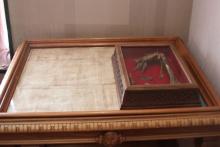 From the Gonio-Apsaros Fortress, we were taken to the city of Zugdidi, whose museum houses many great holy icons and relics, taken from various churches and monasteries between 1923-1936. Among them is the Robe of the Most Holy Theotokos. After the Dormition of the Most Holy Theotokos, this great treasure was kept safe in a Greek church, and was later given to the Byzantine Emperor Leo I the Thracian (r. 457-474). The emperor placed the Robe in the Blachernae Monastery of the Most Holy Theotokos, built especially for that purpose. Later, the Robe was considered lost. Until the 14th century, all historical sources confirm that the Robe was being kept in Constantinople. After the fall of the Byzantine Empire, one archbishop brought the holy relic to Georgia for safekeeping from the Muslims. The Robe then appeared at the Dadiani Palace in Zugdidi, from whence it was taken to the local monastery in Khobi. In 1936, when relics taken from churches and monasteries were handed over to museums, the Robe of the Mother of God returned once more to Dadiani Palace.
From the Gonio-Apsaros Fortress, we were taken to the city of Zugdidi, whose museum houses many great holy icons and relics, taken from various churches and monasteries between 1923-1936. Among them is the Robe of the Most Holy Theotokos. After the Dormition of the Most Holy Theotokos, this great treasure was kept safe in a Greek church, and was later given to the Byzantine Emperor Leo I the Thracian (r. 457-474). The emperor placed the Robe in the Blachernae Monastery of the Most Holy Theotokos, built especially for that purpose. Later, the Robe was considered lost. Until the 14th century, all historical sources confirm that the Robe was being kept in Constantinople. After the fall of the Byzantine Empire, one archbishop brought the holy relic to Georgia for safekeeping from the Muslims. The Robe then appeared at the Dadiani Palace in Zugdidi, from whence it was taken to the local monastery in Khobi. In 1936, when relics taken from churches and monasteries were handed over to museums, the Robe of the Mother of God returned once more to Dadiani Palace.
Many traditions exist regarding the wonderworking power of the Robe. It is known that the Robe of the Mother of God twice saved the Byzantine capital of Constantinople from invasions from the Saracens and Egyptians.
Another miracle was recorded in Georgia in 1891. Bandits stole the Robe from the Khobi monastery. Historical accounts claim that the entire local population took part in the search for it, but without success. Three days later, however, the Robe was miraculously found in the forest, in a spot that shone with an otherworldly light.
The Holy Robe is currently available for veneration by the Orthodox faithful. Every year, on July 2/15, the Georgian Orthodox Church celebrates Vlakernoba (from "Blachernae" – trans.) ‒ a feast in honor of the Robe of the Theotokos. On this day, the Robe of the Mother of God is taken from the museum in Zugdidi to the Cathedral of the Blachernae Icon of the Mother of God, located immediately on the museum grounds, where the faithful are able to venerate this great and holy relic upon the conclusion of the Divine Liturgy.
At the direction of Metropolitan Gerasime of Zugdidi, a moleben was served before the Robe of the Most Holy Theotokos, after which we venerated the great and holy relic. The incorrupt hand of the Great-Martyress Marina and a large portion of the relics of the Great-Martyr & Trophy-Bearer George were brought out for us to venerate, as well.
Filled with grace at having been able to pray before these holy relics, we left Zugdidi to return to Tbilisi. On the way, we stopped in a village, where Metropolitan Daniel prepared another bountiful meal and gathering for us.
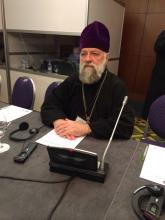 The following morning (May 16), in the central hotel where the sessions of the 5th International Symposium on "The Tradition of the Theotokos’ Veneration in the Orthodox Church" had taken place, a triumphal greeting of the myrrh-streaming Hawaiian Iveron Icon of the Mother of God was held. She was taken to the grand hall and placed on an analogion. It was in this overflowing hall and before this great and holy icon that I presented my lecture, "Two Myrrh-Streaming Icons of the Iveron Mother of God & Brother Jose Muñoz-Cortes." I delivered the lecture in English, with simultaneous Georgian and Russian translations taking place. In my presentation, I noted that the Hawaiian Icon is a direct continuation of the myrrh-streaming of the Montreal-Iveron Icon, which was taken away from us after the 1997 murder of her faithful guardian, Brother Jose Muñoz-Cortes. The Hawaiian Icon was given to the entire Orthodox world in 2007, after two great hierarchs of the Russian Church ‒ His Holiness, Patriarch Alexey II, and His Eminence, Metropolitan Laurus ‒ completed the God-pleasing task of overcoming the division within the Russian Church.
The following morning (May 16), in the central hotel where the sessions of the 5th International Symposium on "The Tradition of the Theotokos’ Veneration in the Orthodox Church" had taken place, a triumphal greeting of the myrrh-streaming Hawaiian Iveron Icon of the Mother of God was held. She was taken to the grand hall and placed on an analogion. It was in this overflowing hall and before this great and holy icon that I presented my lecture, "Two Myrrh-Streaming Icons of the Iveron Mother of God & Brother Jose Muñoz-Cortes." I delivered the lecture in English, with simultaneous Georgian and Russian translations taking place. In my presentation, I noted that the Hawaiian Icon is a direct continuation of the myrrh-streaming of the Montreal-Iveron Icon, which was taken away from us after the 1997 murder of her faithful guardian, Brother Jose Muñoz-Cortes. The Hawaiian Icon was given to the entire Orthodox world in 2007, after two great hierarchs of the Russian Church ‒ His Holiness, Patriarch Alexey II, and His Eminence, Metropolitan Laurus ‒ completed the God-pleasing task of overcoming the division within the Russian Church.
During this session, another clergyman of the Russian Church Abroad, Priest Dimitrij Kalachev from Germany, delivered a lecture entitled, "Protectresses of the Russian Diaspora. Traditions of the German Diocese."
After this session of the symposium, the Hawaiian Icon was taken to a room in the hotel next to the hall where the lectures were being read, where the people of God were given much more time to venerate her. Everyone came ‒ symposium participants, people off the street, hotel staff. Looking at this manifestation of living piety, one had no doubt that we were in a nation with a rich Orthodox spiritual culture. In that same hall, we arranged a photo exhibition dedicated to the Montreal-Iveron Icon of the Mother of God and her murdered guardian, Brother Jose, where we distributed brochures about his life.
On the evening of May 16, Metropolitan Nikoloz of Akhalkalaki & Kumurdo drove Matushka and me by car to his diocesan center in the south of Georgia, near the Turkish and Armenian borders. Georgians call this elevated mountainous region the "Georgian Siberia." Inhabited spots begin appearing at 1,700 meters (5,575 ft.) above sea level, while the most elevated are at 2,100 meters (6,890 ft.), where trees barely grow. Only three percent of the residents in His Eminence’s diocese are Orthodox Christians; the rest are mostly Armenian Christians.
We have known Metropolitan Nikoloz for a long time, from when he was still a bishop. Fourteen years ago, he came to Washington, and we showed him some of the holy sites of ROCOR. In Holy Trinity Monastery in Jordanville, Metropolitan Nikoloz was warmly received by Metropolitan Laurus of blessed memory. In his home, where Metropolitan Nikoloz joyfully receives guests, he built a museum filled with religious artwork, meteorite fragments, puzzles, and taxidermied fish on the window sills.
His Eminence told us that, soon after the opening of his "museum," children began to visit. Following them came the adults. And so, through the labors of Metropolitan Nikoloz, the local population began gradually expressing an interest in Orthodoxy.
His Eminence arranged for us to spend the night in the recently constructed dormitory on the grounds of the diocesan center, where the clergy of his diocese meets annually for several weeks to undergo pastoral courses, which the bishops hold in order to improve their clerics’ education.
Metropolitan Nikoloz’s cathedral is very small, fitting no more than 40-50 people. Hanging on one wall of the church is an icon of the Savior surrounded by various saints; under the icon is a case holding these saints’ relics, which were presented to His Eminence 12 years ago by our Protodeacon Leonid Mickle.
Neighboring the diocesan cathedral, His Eminence had built a chapel of roughly the same size, the entire length of which is taken up by an exact copy of the Shroud of Turin. The chapel’s walls are covered in marvelous frescoes depicting the betrayal of Christ by Judas, the taking down of the Lord’s Body from the Cross and His burial, and the Myrrhbearing Women at the empty sepulcher. At the church, we were greeted by two of Metropolitan Nikoloz’s assistants who, at his instruction, drove us to tour ancient Vardzia.
Vardzia is an outstanding memorial to Georgian fortificational, architectural, and artistic capability. The compound was created in the south of Georgia from 1156-1205 as a fortress and monastery, the goal of which was to defend the Kura River passes from raids by the Persians.
Carved out of the cliff face, the complex was originally designed to be a tower-fortress, and became a well-fortified monastery, which played an important role in the political, cultural, educational, and spiritual life of the nation.
In the center of the complex is Holy Dormition Church, which is covered practically in its entirety with frescoes, among them a remarkable depiction of the Holy Queen Tamar, all of which were preserved under a thick layer of soot. This took place because, in 1551, the monastery was destroyed by the armies of the Iranian Shah Tahmasp, and at the end of the 16th century was seized by the Turks. The barbarians built a massive bonfire out of the disarmed and ailing monks at the very center of Dormition Church, and so the frescoes were immediately covered and blackened with soot; this process continued for many years, as Turkish shepherds would light fires when they sought shelter in the monastery during the winter.
Overall, the compound includes 600 housing, church, and professional rooms, all carved out of the sheer tuff cliff face in nine stories and connected with walkways one to another ‒ churches, cells, halls, libraries, baths, and dining rooms. In case of attack by the enemy, the monastery became a refuge for the surrounding populace, and could hold up to 20,000 people.
From Vardzia, we returned to the diocesan house, where the host was preparing for the arrival of the remaining symposium participants.
That evening, Metropolitan Nikoloz prepared nothing short of a culinary display, comprised of several courses. His Eminence demonstrated his enviable knowledge of Georgian cuisine and treated us to several dishes he had prepared, as well as his own homemade wine. How wonderful it was to be this man’s guest! We returned to Tbilisi late that night.
On May 18, we once again prayed in Holy Trinity Patriarchal Cathedral at the Divine Liturgy, which was celebrated by Catholicos-Patriarch Ilia II.
After the triumphal divine services, we gathered together for a farewell reception at the residence of the primate of the Georgian Church. In his throne room, despite the four-hour service and his evident exhaustion, the Catholicos-Patriarch asked each of the symposium’s participants to share his impressions of Georgia. Each of us spent two to three minutes sharing our observations, and in reply were each rewarded with a Patriarchal blessing and gifts – audio-recordings of His Holiness’ musical compositions, and an album of his sermons in English.
From the Patriarchal residence, we departed for Mt. Makhata, where the Cathedral of the Iveron Icon of the Mother of God is being built. On the mountainside, each symposium participant planted a small tree in memory of his visit to the first appanage of the Most Holy Theotokos.
On the evening of May 18, we gathered for a final banquet in a restaurant at one of the highest points in Tbilisi with a wonderful panoramic view of the city, adorned at its center by Holy Trinity Cathedral.
On May 19, Fr. Mikheil Popkhadze and his Matushka Ketevan drove us to the eastern part of Georgia – to Kakheti, to Bodbe Monastery to venerate the relics of the Holy Equal-of-the-Apostles Nina.
The monastery was founded in the fourth century, after the repose of St. Nina, on the spot that the saint had chosen as her final shelter. We were greeted by the energetic Abbess Theodora, who blessed us to sing an akathist at the relics of St. Nina; we were also allowed to bless many small icons, which we were to distribute to our parishioners, on her relics.
Left in ruins by the communists, the ancient Bodbe Monastery has found new life in our days. In 1991, the holy habitation began to be restored. Currently, the convent houses about 30 nuns. Under the direction of their rectress, Abbess Theodora, the sisters have tirelessly labored and taken care for the establishment and beautification of the monastery. St. Nina’s tomb has been adorned, the half-demolished buildings have been rebuilt, and a font has been built over St. Nina’s spring, as well as a small church in honor of the saint’s parents ‒ Sts. Zebulon & Susanna. A grand cathedral is being built. The monastery has a large, self-sustaining farm, and a functioning icon studio and sewing shop specializing in goldwork embroidery. The nuns also take part in literary work, a traditional practice in Georgian monasteries: working from ancient manuscripts, they are preparing service books for publication. Most importantly, daily services for the peace and prosperity of Georgia and the entire Orthodox world are served at the tomb of St. Nina.
Unfortunately, we could not stay long at Bodbe, as we still had to visit the similarly renowned Samtavro Monastery.
The Samtavro Convent is one of the holiest places in Orthodox Georgia. St. Nina lived in this place for some time, under a blackberry bramble. The monastery has existed for 17 centuries; now the convent is located in the very center of Mtskheta, but when St. Nina arrived here, it was all fields.
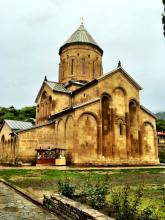 Located in Samtavro’s Holy Transfiguration Church is a multitude of holy relics, including a piece of the Life-Giving Pillar, a wonderworking Iveron Icon of the Mother of God, the tombs of Sts. King Mirian & Queen Nana, and the relics of the Holy Hieromartyr Abibos Nekreseli, Venerable Shio Mgvime (the Anchorite – trans.), and the Venerable-Confessor Gabriel, glorified in 2012.
Located in Samtavro’s Holy Transfiguration Church is a multitude of holy relics, including a piece of the Life-Giving Pillar, a wonderworking Iveron Icon of the Mother of God, the tombs of Sts. King Mirian & Queen Nana, and the relics of the Holy Hieromartyr Abibos Nekreseli, Venerable Shio Mgvime (the Anchorite – trans.), and the Venerable-Confessor Gabriel, glorified in 2012.
We blessed the icon of St. Gabriel, given to our Washington parish by the above-mentioned group of Georgian faithful, on his relics, and sang his Magnification.
The Elder Gabriel knew neither fear nor falsehood. In 1965, he torched a giant portrait of Lenin on the May 1st holiday, in order to "destroy the idol," and began preaching Christ to those who had gathered to watch. For this, he was severely beaten and placed in isolation at the Georgian KGB headquarters. When interrogated, Fr. Gabriel admitted to burning the portrait of the Bolshevik leader, because "you cannot deify man. Where Lenin’s portrait hung, you should be hanging Christ’s Crucifix. Man has no need for glory. You should write, ‘Glory to Jesus Christ.’" In August 1965, Fr. Gabriel was institutionalized in a psychiatric hospital.
Fr. Gabriel settled in Samtavro in the 1980s. For a time, the nuns were taken aback by the elder’s eccentricities, until they witnessed a certain ascetic labor in them. The elder came to be called "the great love of the 20th century." He would often wear a tablet on his chest that read, "A man without love is like a bucket without a bottom." The elder would say, "Love stands above all canons and rules. If you hate even one person, then you are despised of God. You must love all. But if you cannot do this, then at least wish everyone well. In the last times, people will be saved by love, humility, and kindness. Kindness will open the gates of Paradise, humility will bring you in, and love will reveal God."
Fr. Gabriel died of dropsy on November 2, 1995. In accordance with his will, the elder’s body was wrapped in a mat and buried in the ground were St. Nina had led her ascetic labors.
The tomb with Elder Gabriel’s incorrupt relics was the last holy site we visited in Georgia. The following morning, we bade farewell to the first earthly appanage of the Most Holy Theotokos, and after a two-day visit to Constantinople (perhaps we will write more about the capital of ancient Byzantium at a later date), offering glory to God for all that we had seen and heard, returned home.
Archpriest Victor Potapov
June 2014
Media Office of the Eastern American Diocese
Relics in cathedral - monthly calendar
| S | M | T | W | T | F | S |
|---|---|---|---|---|---|---|
|
|
1
|
2
|
3
|
4
|
5
|
6
|
|
7
|
8
|
9
|
10
|
11
|
12
|
13
|
|
14
|
15
|
16
|
17
|
18
|
19
|
20
|
|
21
|
22
|
23
|
24
|
25
|
26
|
27
|
|
28
|
29
|
30
|
|
|
|
|
PARISH LIFE
RECENT VIDEOS
Address of our Cathedral
Subscribe to our mailing list
While all the materials on this site are copyrighted, you may use them freely as long as you treat them
with respect and provide attribution on the Russian Orthodox Cathedral of St.John the Baptist of Washington DC.


